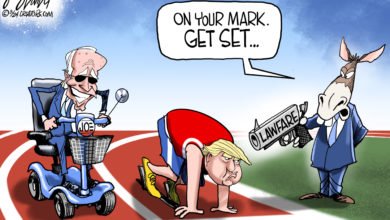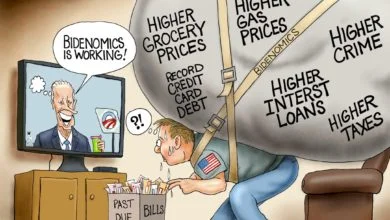Sectarianism: How It Arose, and How to Solve It
Amid the rapid rise of political sectarianism, the modern presidency has become a divider rather than a mender.
In a news conference on the final day of his first year in office, President Joe Biden, in an effort to divert attention from divisions in his own party, blamed Senate Republicans for blocking his top agenda items.
“One thing I haven’t been able to do so far,” the frustrated president said, “is get my Republican friends to get in the game of making things better in this country.”
While Biden is right that Republicans are opposing him at every turn, his condemnations are surely not making things any better. In fact, he only seemed to exacerbate the partisan contempt that has become pervasive and toxic in recent years.
A recent poll found that half of Americans experience their family as more divided than five years ago. Another showed that roughly four of ten registered voters do not have a single close friend who supports the other major party candidate. Today, 84 percent of Republicans believe that the Democratic Party is taken over by socialists, while 85 percent of Democrats believe that the Republican Party is taken over by racists.
An even more sobering poll last fall found that 75 percent of Biden voters and 78 percent of Trump voters view Americans who strongly support the opposing party as presenting a clear and present danger to democracy.
Origins of Sectarianism
Beneath the scent of fire and brimstone in America’s vindictive politics, political sectarianism is caused by two psychological mechanisms inherent in every human being: othering and cognitive dissonance.
“Othering” is a situation when some individuals or groups are defined and labeled as not fitting within a group. This “us vs. them” way of thinking about human connection affects how people treat those presumably in the in-group and those in the out-group.
In a series of studies known as the Robbers Cave Experiment, researchers found how intergroup conflicts can arise from the smallest differences. In the experiment, researchers separated 22 young boys into two groups and allowed them to develop attachment by doing various activities such as hiking, swimming, etc. Then, they pitted the groups against each other in competition.
In the subsequent few days, hostilities and prejudice emerged. When asked to list the features of the other group, the boys tended to perceive the other group as having a host of negative traits while believing their own group had a host of positive traits. As cooperation and cohesiveness grew within each group, each group became more hostile to the other.
The second mechanism is “cognitive dissonance.” This describes the mental discomfort experienced when a person encounters contradictory information. To alleviate the discomfort, people often search for new information or develop new justifications to confirm their existing beliefs.
For example, an alcoholic may continue drinking despite knowing that it is detrimental to his health. While he can decide that he values the ephemeral pleasure of drinking more than he values the long-term effects of health, he can also convince himself that drinking wine provides antioxidants which lowers the risk of heart attacks.
Cognitive dissonance explains why people fiercely adhere to their candidates or ideologies even when presented with evidence that these candidates and ideologies are destructive or evil. This is shown as a decreased willingness to adjust political attitudes and to make even the faintest compromises. No matter how concrete opposing arguments are, one is still inclined to insulate his beliefs from these contradictory assertions.
A High-Stakes Presidency
Amid the rapid rise of political sectarianism, the modern presidency has become a divider rather than a mender.
In a 2021 article, professors John McGinnis and Michael Rappaport attributed current conditions to “the deformation of our governmental structure.”
“Because unilateralism allows the President and the Supreme Court to impose policies that do not have the support of moderates,” they argued, extreme outcomes are encouraged as the president is able to institute partisan policies without a broad consensus. The result is that policies shift radically between different administrations, irritating the opposition party and frustrating attempts to unify the nation.
For instance, in 2012, not long after winning his second term, President Obama issued orders offering legal status and financial benefits to the 11 million undocumented immigrants in the country. A few years later, President Trump repealed these orders and banned refugees and visa holders from seven countries. Not long after, President Biden proposed an immigration bill which would legalize an additional 11 million immigrants.
The increased delegation of legislative power to the executive branch has also allowed fundamental governing issues usually settled by Congress to be resolved by the president and his agencies. This is demonstrated by the wanton issuance of executive orders. While Trump was widely criticized for vetoing orders from previous administrations and issuing a plethora of executive orders himself, Biden took a step further by issuing 17 executive orders in his first two days as president, more than any recent president did in his first 100 days. As of Jan. 20, 2022, Biden had issued an average of 77 executive orders per month, exceeding Obama’s 35 and Trump’s 55 per month.
The extraordinary power of the president to change the law of the land at the stroke of a pen increases the stake of the office. Rather than merely removing some obstacles from the previous administration, the modern presidency now decides on controversial issues which are relevant to millions of Americans.
This collides with the in-built mechanisms of othering and cognitive dissonance. Now, when an in-group seizes the opportunity, they can unleash their fury at the out-group by dismantling the efforts of previous administrations and even punishing them. Resentment and hatred add up, leading to a vicious circle of violence and reprisal.
Further, with the rise of information platforms and charismatic commentators, more and more partisans are capable of curating their daily news input. When people consciously choose the information from which they seek consolation and develop arguments, the partisan gap over polarizing issues only widens, affecting the actions of officials who need to satisfy the demands of their constituents.
The Next Step
Politics invariably leads to disharmony. “The latent causes of faction,” James Madison told us in Federalist No. 10, “are sown into the nature of man.” The psychological mechanisms of othering and cognitive dissonance are, whether we like it or not, embedded in the human mind.
Political sectarianism is thus unavoidable, in the sense that people will always disagree about things. This is why political forums and bipartisan meetings, both well-intended ideals aimed at alleviating America’s feverish politics, are largely ineffective.
Instead, we should focus on what really exacerbates the situation: the presidency. We should limit the expansive power of the presidency and the damage it incurs, reining in its prerogatives of executive orders, emergency powers, war powers, and its ability to make laws with the stroke of a pen.
The modern presidential office has regrettably become a winner-take-all death match which harms everyone involved. Only by reining in the power of the presidency can we lower the stake of this partisan war and therefore its accompanying antagonism.
If we do not act on this premise, we are only putting ourselves into an irrevocable plight. Concentrated power by its very nature is too dangerous to exist, and by giving in to the whims of the “most powerful office in the world,” we are only endangering our liberty and our commitment to a peaceful coexistence.
Content syndicated from Fee.org (FEE) under Creative Commons license.
Agree/Disagree with the author(s)? Let them know in the comments below and be heard by 10’s of thousands of CDN readers each day!




